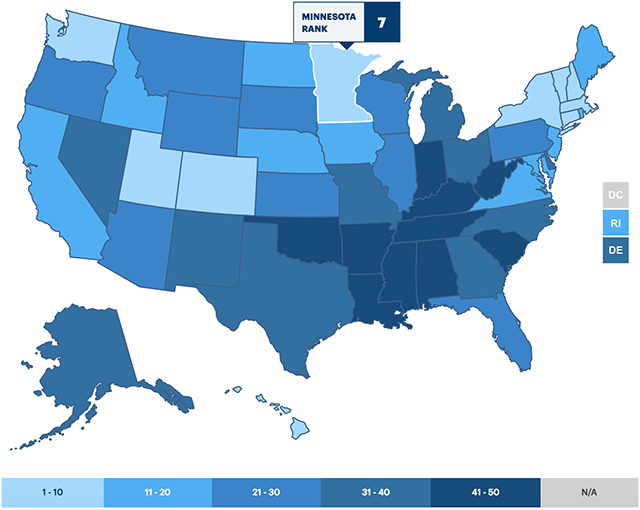The United Health Foundation’s 29th “Annual Health Rankings” report, which was released on Thursday, has some good and some not-so-good news for Minnesota.
The report grades all 50 states and the District of Columbia on a wide range of “determinants of health,” including obesity rates, drug deaths, preventable hospitalizations, rates of physical inactivity, salmonella food poisoning, air pollution and public health funding.
Minnesota dropped in the 2018 rankings for the second time in two years, from sixth to seventh place. Although that’s still a respectable slot to fill, it’s the lowest the state has ever been ranked in the report. And it’s certainly a considerable fall from the first-place position that Minnesota held for six out of seven years between 2000 and 2006.
The states above us in the 2018 rankings are (from top down) Hawaii, Massachusetts, Connecticut, Vermont, Utah and New Hampshire.
The states at the other end of the rankings are (from bottom up) Louisiana, Mississippi, Alabama, Arkansas, Kentucky and West Virginia.
Minnesota continues to out-rank its near neighbors, however. The report lists North Dakota 13th, Iowa 18th, Wisconsin 23rdand South Dakota 25th.
Strengths and challenges
The United Health Foundation bases its annual health rankings reports on data collected from a variety of sources, including the Centers for Disease Control and Prevention, the American Medical Association, the U.S. Census Bureau, and the U.S. Environmental Protection Agency.
According to the 2018 report, Minnesota’s key strengths are a low cardiovascular death rate, a low percentage of uninsured people, a low prevalence of people reporting frequent mental distress and a low rate of premature death.

[image_credit]United Health Foundation[/image_credit][image_caption]Minnesota dropped in the 2018 rankings for the second time in two years, from sixth to seventh place.[/image_caption]
Among Minnesota’s challenges, according to the 2018 report, are a low rate of children immunizations (we’re ranked 48thin that category); a high incidence of pertussis, or whooping cough (46th); and a high prevalence of excessive drinking (46th).
Here are some of Minnesota’s other highlights — and lowlights — from the report:
- During the past five years, the proportion of Minnesota children living in poverty decreased by 19percent, from 14.8 percent to 11.8 percent. Interestingly, that is the same percentage drop that occurred nationwide.
- During the past three years, meningitis immunizations among Minnesota’s adolescents aged 13 to 17 increased 32 percent, from 66.3 percent to 87.5 percent.
- During the past 10 years, drug deaths in the state increased 100 percent, from 5.4 to 10.8 deaths per 100,000 Minnesotans.
- During the past five years, confirmed cases of salmonella food poisoning in the state increased 17 percent, from 13.6 to 15.9 cases per 100,000 Minnesotans.
- During the past two years, the state’s adult obesity rate increased 9 percent, from 16.1 percent to 28.4 percent.
Across the country
Here are some of the national trends highlighted in the report:
- For the first time in the history of the “Annual Health Rankings,” the obesity rate among American adults exceeded 30 percent. The rate jumped by 5 percent during the past year, from 29.9 percent to 31.3 percent. “Obesity continues to be a leading cause of cardiovascular disease and cancer — chronic diseases that are contributing to premature death rates,” the report notes.
- Although the national cancer death rate has been declining since 1990, more than 30 states have experienced increases or have not see their rates improve significantly. (Minnesota is not among those 30 states.) The top three states where cancer death rates have increased the most are Oklahoma (up 12 percent between 1990 and 2018), Mississippi (up 11 percent) and Kentucky (up 11 percent).
- The suicide rate in the United States has increased 16 percent since 2012, from 12 to 13.9 deaths per 100,000 people. “More Americans are also reporting poor mental health for 14 or more days out of the last month, with frequent mental distress now impacting nearly one in eight adults,” the report adds. “In fact, self-reported mental distress measured by the Behavioral Risk Factor Surveillance System (BRFSS) increased 7 percent over the past two years.”
FMI: You’ll find the full report, including a section specifically on Minnesota, at the United Health Foundation’s website.






One stark takeaway stat: In just the last two years, the state’s adult obesity rate jumped from 16.1 percent to 28.4 percent. A huge jump.
And yet doctors still push the high carb low fat diet.
A two-year gain of this magnitude for a large population is very unlikely. It is more likely that the measurement was changed or there was a mistake somewhere. The 16.1% for two years ago seems extremely low and probably was 26.1%. The numbers for early childhood vaccinations in total and for income groups cry out for more context.
Which is a 12.3% increase, not a 9% increase as stated in the article. Which I suppose makes it even worse. And 30% nationwide. Not that long ago obesity was a rarity.
Must be a typo. Almost certainly increased from 26.1% to 28.4 (or a 2.4% percent increase or 8.1% rate increase). If not, the numbers on obesity in MN make no sense.
Unfortunately, obesity is a rising problem in other nations, also. America has exported fast food restaurants and convenience stores selling junk food, which have changed diets, especially for youngsters. It is common to see older people slim or of regular weight due to eating their traditional foods, while young people more often are overweight after consuming fast food, chips, coca cola, etc.
Oh Please! The obesity rate has been rising since the 1970’s before anyone every heard of a growler and craft beer was Heineken or Moosehead. Do you think a combination of higher nutrient empty calorie content, lack of life long exercise and home/work demands that favor fast food and reduce opportunity for exercise might have something to do with the obesity rise?